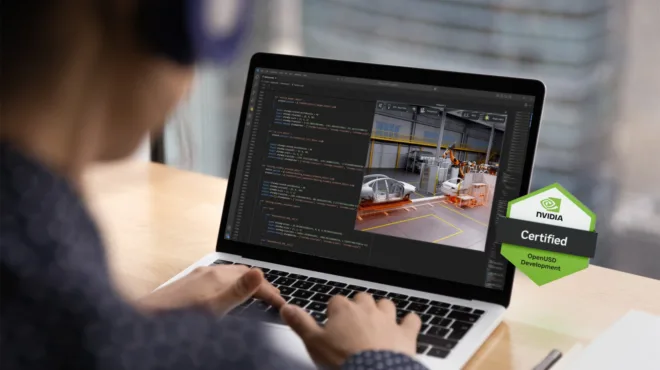At SIGGRAPH 2025, NVIDIA released general access for NVIDIA Isaac Sim and NVIDIA Isaac Lab reference robotics simulation and learning frameworks. Now available on GitHub, these releases offer access to cutting-edge capabilities for building, training, and testing AI-powered robots in physics-based simulation environments.
What’s new in Isaac Sim 5.0?
Isaac Sim is a reference application built on NVIDIA Omniverse that enables users to develop, simulate, and test AI-driven robots in physically based simulation environments. Major Isaac Sim 5.0 updates are detailed in the following sections.

Open source availability
Extensions specific to Isaac Sim are being open sourced and are available in a public GitHub repository, which enables users to build and run Isaac Sim. Note that components of Omniverse Kit remain closed source, and external contributions are not accepted at this time.
Neural reconstruction and rendering
NVDIA Omniverse NuRec libraries enable developers to turn real world images into high-fidelity, interactive simulation. To create Isaac Sim-compatible scenes, developers can use the open-source tool 3DGUT. It provides workflows for training 3D Gaussian models from image datasets and exporting them in a USD-based format compatible with Kit-based applications.
For a complete tutorial on how to load a scene generated with NuRec and run a simulation in Isaac Sim, refer to the Isaac Sim documentation.

Easy accessibility with NVIDIA Brev
Isaac Sim 5.0 is now accessible through NVIDIA Brev, which provides developers with instant access to NVIDIA RTX-enabled GPU instances across major cloud providers, eliminating infrastructure overhead and accelerating iteration cycles. As a developer, you can customize your deployment by selecting instance types and port configurations.
Create an NVIDIA Brev account, deploy a GPU instance (for one NVIDIA L40S GPU, for example), and expose ports 49100 and 47998 for WebRTC streaming access.
Get the public address of the instance using the following script:
curl -s ifconfig.me
Pull the Isaac Sim Container using docker pull:
docker pull nvcr.io/nvidia/isaac-sim:5.0.0
Run the Isaac Sim container in headless mode:
docker run --name isaac-sim --entrypoint bash -it --runtime=nvidia --gpus all -e "ACCEPT_EULA=Y" --rm --network=host \
-e "PRIVACY_CONSENT=Y" \
-v ~/docker/isaac-sim/cache/kit:/isaac-sim/kit/cache:rw \
-v ~/docker/isaac-sim/cache/ov:/root/.cache/ov:rw \
-v ~/docker/isaac-sim/cache/pip:/root/.cache/pip:rw \
-v ~/docker/isaac-sim/cache/glcache:/root/.cache/nvidia/GLCache:rw \
-v ~/docker/isaac-sim/cache/computecache:/root/.nv/ComputeCache:rw \
-v ~/docker/isaac-sim/cache/computecache:/root/.nv/ComputeCache:rw \
-v ~/docker/isaac-sim/logs:/root/.nvidia-omniverse/logs:rw \
-v ~/docker/isaac-sim/data:/root/.local/share/ov/data:rw \
-v ~/docker/isaac-sim/documents:/root/Documents:rw \
nvcr.io/nvidia/isaac-sim:5.0.0
Use the WebRTC streaming client to remotely access and interact with Isaac Sim running on the cloud GPU instance through your web browser:
PUBLIC_IP=$(curl -s ifconfig.me) && ./runheadless.sh
--/app/livestream/publicEndpointAddress=$PUBLIC_IP --/app/livestream/port=49100
View more detailed instructions on how to use Brev.
Advanced synthetic data-generation pipelines
Isaac Sim introduces several new extensions that expand synthetic data generation (SDG) capabilities for training, testing, enabling rapid creation of diverse datasets, and validating AI-powered robots.
- MobilityGen: Available as extensions in Isaac Sim, MobilityGen enables diverse physics and perception-based data generation, such as occupancy maps, robot states, poses, velocities, and images.
- Grasp data generation: Available as a new tutorial introducing a workflow, this enables automated generation of grasp candidates, simulating each grasp attempt, and recording success metrics for training and evaluation.
- A new writer for NVIDIA Omniverse Replicator: Optimized for NVIDIA Cosmos Transfer input, for users to easily generate and export high-quality synthetic data for ingestion. It supports standalone workflows and the Script Editor, and can be seamlessly integrated into existing Isaac Sim SDG scripts.
- Action and Event Data Generation: A new reference application in Isaac Sim that supports SDG for large-scale indoor environments like warehouses and factories. Three new extensions enable users to generate scene actors, objects, and physical events found in the real world. VLM Scene Captioning accelerates the data annotation process with comprehensive captions that includes how objects and actors relate to each in time, space, and size.
New robot models
Isaac Sim 5.0 introduces new robot models and import tools that make simulation setup faster, more consistent, and closer to real-world behavior.
- A new robot schema standardizes robot definitions in OpenUSD, now adopted across the NVIDIA expanded robot asset library featuring new robot models. Robot importers now use the new robot schema, and the new Robot Import Wizard offers a streamlined, step-by-step process for rigging and importing robots for simulation.
- The new schema in Isaac Sim 5.0 also supports a new joint friction model defined through an OpenUSD schema, including actuator and friction parameters, developed in collaboration with Hexagon Robotics and maxon. These models ensure that the actuation of joints and motors in simulation closely mirrors real-world system dynamics, reducing the simulation-to-real gap.
Improved sensor simulation
Isaac Sim now offers a major leap in sensor simulation, making it easier than ever to define and test sensor models with greater realism and control.
- A new OmniSensor USD schema will define RTX sensors directly within USD, alongside a new depth sensor model that simulates realistic stereo depth with detailed disparity artifacts. Additionally, the asset library has been expanded to include new sensor models.
Standardized ROS 2 interfaces and ZMQ bridge
Isaac Sim 5.0 offers full support for ROS 2 Jazzy Jalisco, a new ZeroMQ bridge , and an updated MoveIt 2 Tutorial for motion planning workflows.
Additionally, the new standardized ROS 2 simulation interfaces address a long-standing challenge in robotics by providing a unified method for controlling various simulators through ROS 2. Led by Robotec.ai and developed in collaboration with Gazebo, Open 3D Engine, and NVIDIA, these interfaces streamline integration by offering developers a consistent and simplified way to manage simulations directly from ROS 2.
What’s new in Isaac Lab 2.2?
Isaac Lab is an open-source framework purpose-built for training and evaluating robot learning policies. The new updates to Isaac Lab 2.2 include:
- Now available as a Launchable on NVIDIA Brev: Isaac Lab 2.2 launchable is now available on NVIDIA Brev. Try the latest version of Isaac Lab and Isaac Sim in a few simple steps. Instructions and project repo here.
- Enhanced synthetic motion generation: This amplifies collected data for robot manipulation using NVIDIA Isaac GR00T-Mimic’s bi-manual training environment.
- Omniverse Fabric integration: Isaac Lab now supports Fabric for faster load times and more efficient execution of physics simulations and sensor data collection.
- Tensorized suction cup gripper: This provides flexible, dynamic gripping simulation, essential for accurate reinforcement learning and manipulation tasks.

Policy evaluation
Advancements in robotic policy development now demand efficient and large-scale closed-loop policy evaluation in simulation. Streamlining these workflows and leveraging state-of-the-art agentic and neural technologies can transform simulation-based learning into a high-velocity innovation engine.
Lightwheel and NVIDIA are actively collaborating to bring open source policy evaluation framework and benchmarks on Isaac Lab. This initiative will lower barriers to entry, foster community collaboration and empower robotics developers to conduct complex, large-scale evaluations more efficiently.
Ecosystem adoption
Amazon Lab126, Boston Dynamics, Figure AI, Haply Robotics, Hexagon, RAI Institute, Resim.ai, Lightwheel, and Skild AI are adopting NVIDIA Isaac libraries and AI models—such as Isaac Sim and Isaac Lab—to accelerate their AI robotics development.
Get started building AI-powered robots in physics-based simulation environments
To get started with the general access versions of Isaac Sim 5.0 and Isaac Lab 2.2, download the source code from GitHub.
To learn more, see Advanced Sensor Physics, Customization, and Model Benchmarking Coming to NVIDIA Isaac Sim and NVIDIA Isaac Lab.
Watch the NVIDIA Research special address at SIGGRAPH 2025.
Stay up to date by subscribing to our newsletter and following NVIDIA Robotics on LinkedIn, Instagram, X, and Facebook. Explore NVIDIA documentation and YouTube channels, and join the NVIDIA Developer Robotics forum. To start your robotics journey, enroll in our free NVIDIA Robotics Fundamentals courses today.
Get started with NVIDIA Isaac libraries and AI models for developing physical AI systems.










